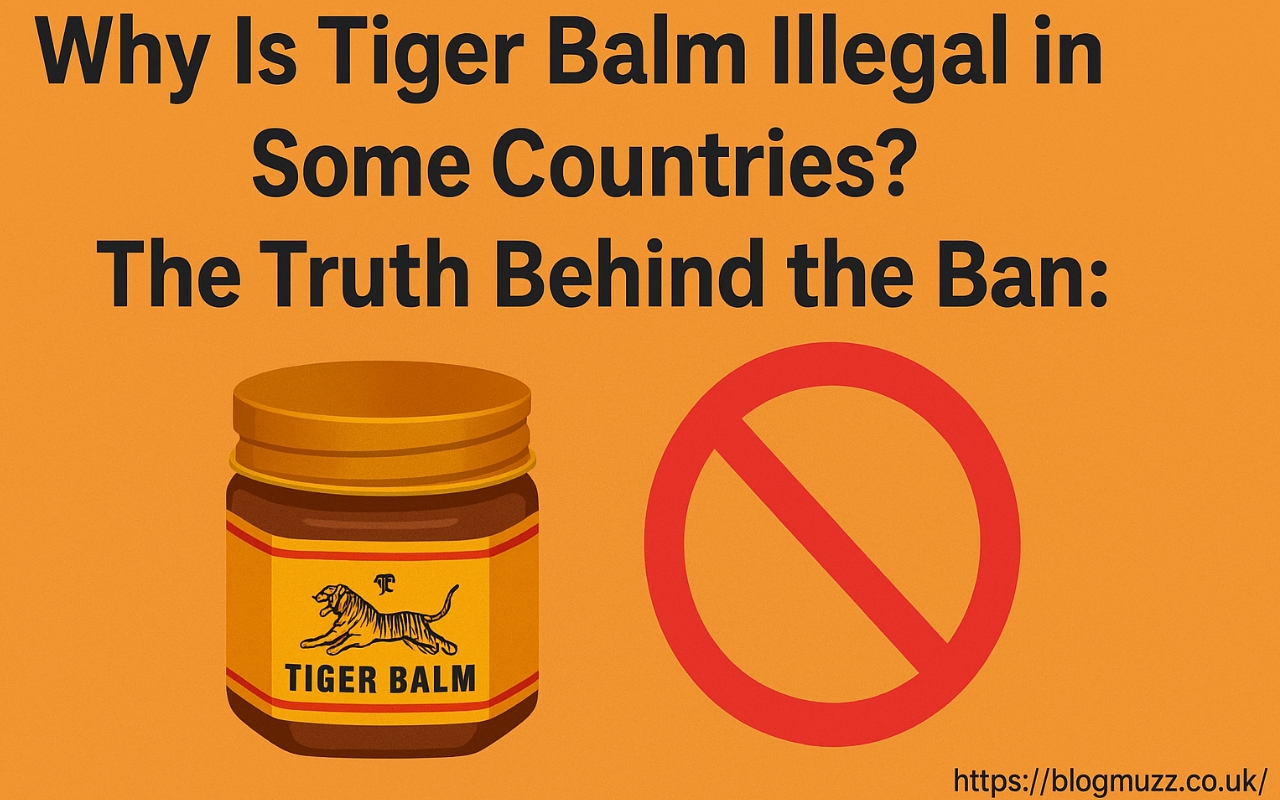For over a century, Tiger Balm has been a household remedy used to relieve headaches, sore muscles, and joint pain. But recently, the internet has been buzzing with a surprising question: why is Tiger Balm illegal in some countries?
While millions swear by its soothing properties, a few regions have restricted or banned certain formulations of this iconic ointment. The reason isn’t what most people think. In this in-depth guide, we’ll uncover the truth behind the Tiger Balm ban, its ingredients, the laws surrounding it, and how you can safely (and legally) use it today.
What Is Tiger Balm and Why Is It So Popular?
Tiger Balm is a well-known topical ointment first developed in the late 19th century by Chinese herbalists Aw Boon Haw and Aw Boon Par in Burma (now Myanmar). The brand’s name comes from the word “Haw,” which means “Tiger” in Chinese — a symbol of strength and healing in Eastern culture.
Over the years, Tiger Balm became a global product, sold in more than 100 countries and trusted for its effectiveness in relieving:
- Muscle aches and sprains
- Joint pain and stiffness
- Back pain
- Tension headaches
- Nasal congestion
- Insect bites
What made it special was not just its traditional heritage, but its instant cooling and warming effect that helped relax muscles and increase circulation. However, this unique formulation is also what placed it under the regulatory microscope in certain countries — leading to the question, why is Tiger Balm illegal in some places?
The Secret Behind Its Strength: Ingredients in Tiger Balm
To understand why some nations restrict or ban Tiger Balm, we need to look at what’s inside it. The key active ingredients in most formulations are:
- Camphor (11 – 25%) – the primary counter-irritant that produces a warming sensation to distract from pain.
- Menthol (8 – 16%) – a cooling compound derived from mint oils that soothes and refreshes.
- Cajuput Oil – an essential oil that provides warmth and enhances circulation.
- Clove Oil – known for its mild numbing effect.
- Mint Oil – adds fragrance and cooling relief.
- Base (paraffin, petroleum jelly, or beeswax) – helps spread the balm evenly.
While all of these are naturally derived and beneficial in small quantities, camphor and menthol are regulated substances in many countries due to their potential toxicity at high concentrations. That’s where the legal issues begin.
The Main Issue: Camphor and Menthol Regulations
One of the primary answers to why is Tiger Balm illegal lies in camphor regulation.
Camphor is safe when used topically in limited amounts, but when ingested or absorbed excessively, it can be toxic — especially to infants and small children. High levels of camphor may cause nausea, dizziness, seizures, or even life-threatening reactions.
Because of these risks, the U.S. Food and Drug Administration (FDA) strictly limits camphor concentration in over-the-counter products to no more than 11%. Yet, some traditional versions of Tiger Balm (particularly those sold in Asian markets) contain up to 25% camphor, exceeding the limit.
Similarly, menthol — although naturally soothing — can also irritate sensitive skin or trigger breathing issues in babies when used near the nose or mouth. Some regulators view these ingredients as needing tighter control.
Therefore, while Tiger Balm is not banned outright, specific high-camphor variants are not approved for sale in countries like the U.S. and parts of Europe.
Country-by-Country: Where Tiger Balm Faces Restrictions
Let’s look closer at where and why Tiger Balm might be considered “illegal” or restricted.
United States
Tiger Balm itself is legal in the U.S., but only the low-camphor formulation (≤ 11%) is approved for over-the-counter sale. Older or imported jars with 20–25% camphor are not FDA-compliant and may be seized by customs.
European Union
Most EU nations classify Tiger Balm as a medicinal product. Products containing more than the permitted camphor or menthol percentages cannot be marketed without regulatory approval.
South Korea
In 2025, South Korea’s consumer safety agency warned against herbal products like Tiger Balm and Yadom oils due to undeclared allergens and high menthol content. While not “banned,” such warnings often lead to tighter import and labeling rules.
Middle East and Some African Countries
In certain regions, Tiger Balm imports have occasionally been blocked due to unregistered formulations or mislabelled packaging.
Australia and New Zealand
Tiger Balm is legal but regulated. Only approved formulas meeting Therapeutic Goods Administration (TGA) standards may be sold.
The bottom line? Tiger Balm is not globally banned. It’s simply that certain versions cannot be sold or imported where ingredient concentrations exceed safety standards.
The Most Common Myths About the Tiger Balm Ban
Over time, misinformation has spread about why Tiger Balm might be illegal. Let’s clear up the biggest myths:
Myth #1: It Contains Real Tiger Parts
Despite the name, Tiger Balm does not contain any tiger bones, oils, or animal derivatives. The brand name is symbolic — representing strength and vitality — not an ingredient list.
Myth #2: It’s Banned Everywhere
In reality, it’s legal in most parts of the world. Only certain high-strength variants are restricted or need approval before sale.
Myth #3: It’s Dangerous for Everyone
When used correctly on intact skin and as directed, Tiger Balm is safe for adults. Most problems arise from overuse, ingestion, or application to children’s skin or near mucous membranes.
Myth #4: Customs Seizures Mean It’s Illegal
Sometimes imported balms are seized not because of toxicity, but due to labeling violations or lack of official registration. That doesn’t make the product itself illegal.
These myths show how social media and word-of-mouth can easily distort facts — turning a regulatory nuance into a viral “ban story.”
The Real Safety Concerns Behind Tiger Balm
Regulators don’t restrict Tiger Balm without reason. There are legitimate safety considerations that justify the caution.
1. Camphor Toxicity
If swallowed — even small amounts — camphor can cause seizures or poisoning. Young children are most at risk, which is why authorities strictly limit camphor concentration in topical products.
2. Skin and Respiratory Reactions
Essential oils like clove and cajuput can sometimes cause allergic reactions or dermatitis. Menthol vapors, if applied too close to a baby’s nose, can irritate airways and lead to respiratory distress.
3. Misuse or Over-Application
Some users apply too much balm or combine it with heating pads, thinking it will increase pain relief. In reality, this can lead to chemical burns or severe irritation.
4. Counterfeit Products
Another factor driving restrictions is the proliferation of fake Tiger Balm jars. These counterfeit versions may contain harmful additives or inconsistent concentrations, posing real health risks.
Because of these issues, some governments temporarily suspend certain imports or enforce stricter labeling laws — adding to the confusion over why Tiger Balm is illegal in some places.
How Regulatory Laws Differ Around the World
Each country’s health authority applies different standards to herbal products and topical analgesics:
- FDA (USA): Caps camphor at 11% for non-prescription use.
- European Medicines Agency (EMA): Requires clinical data for products claiming therapeutic benefits.
- Therapeutic Goods Administration (Australia): Approves only specific registered formulations.
- Health Canada: Categorizes it as a Natural Health Product (NHP) but with restrictions on concentrations.
This means a jar legally sold in Singapore may not automatically be legal in the UK or the U.S. It’s a matter of local compliance, not illegality.
The Marketing and Cultural Factor
Another subtle reason for the “illegal” reputation is marketing itself.
Tiger Balm has deep roots in Traditional Chinese Medicine (TCM) — a system that sometimes clashes with Western regulatory standards.
While Asian markets treat it as a trusted home remedy, Western regulators classify it as a pharmaceutical-like product, demanding rigorous safety and labeling data. This mismatch occasionally leads to delays in registration or import restrictions.
At the same time, Tiger Balm’s global fame makes it a target for copycats. Poorly made imitations can cause side effects, prompting government recalls that inadvertently tarnish the genuine brand’s reputation.
How to Use Tiger Balm Safely and Legally
If you love Tiger Balm’s pain-relieving magic, the good news is that you can still use it safely in most parts of the world. Just follow these guidelines:
Read the Label
Always check the camphor and menthol percentages. If you’re in the U.S. or EU, make sure it’s an officially approved formulation (≤ 11% camphor).
Apply Correctly
Use a thin layer on the affected area. Avoid open wounds, eyes, nose, or mouth.
Age Restrictions
Do not use on infants or young children under two years old. Their skin and respiratory systems are more sensitive.
Avoid Overuse
More balm does not equal more relief. Over-application may lead to burns or irritation.
Buy from Reputable Sources
Purchase only from official stores or licensed pharmacies to avoid counterfeit or illegal imports.
Travel Considerations
If traveling, check your destination country’s import limits. Some airports may restrict bringing medicinal products without prescription or proper labeling.
Following these safety and legal steps ensures you can enjoy the benefits of Tiger Balm without crossing any regulatory lines.
The Future of Tiger Balm and Global Herbal Products
As consumers become more health-conscious, herbal and traditional medicines like Tiger Balm are gaining renewed popularity. But increased scrutiny also means companies must adapt to stricter rules.
Expect to see:
- Reformulated versions with safer concentrations to meet global standards.
- Improved packaging and labeling, including allergen and child-safety warnings.
- Digital verification systems to detect counterfeits.
- Harmonization of herbal medicine regulations across major markets.
Tiger Balm’s manufacturer, Haw Par Corporation, continues to modernize its brand while preserving its heritage — ensuring it remains a trusted name rather than a controversial one.
Conclusion: The Real Answer to “Why Is Tiger Balm Illegal”
After all the myths, confusion, and half-truths, here’s the honest answer:
Tiger Balm is not truly illegal.
It is, however, regulated differently across countries due to variations in camphor and menthol concentration, labeling, and safety standards.
In short:
- It’s legal and widely available in most nations.
- Certain high-strength or unregistered formulations are restricted or non-compliant.
- Misuse, counterfeit versions, and regulatory misunderstandings fuel the “illegal” myth.
If you stick to authorized versions, use them safely, and respect import rules, you can confidently enjoy Tiger Balm’s soothing relief — without worrying about breaking any laws.
So the next time someone asks, “Why is Tiger Balm illegal?” you’ll know the full truth: it’s not a dangerous banned substance — just a powerful traditional remedy navigating modern global regulations.



